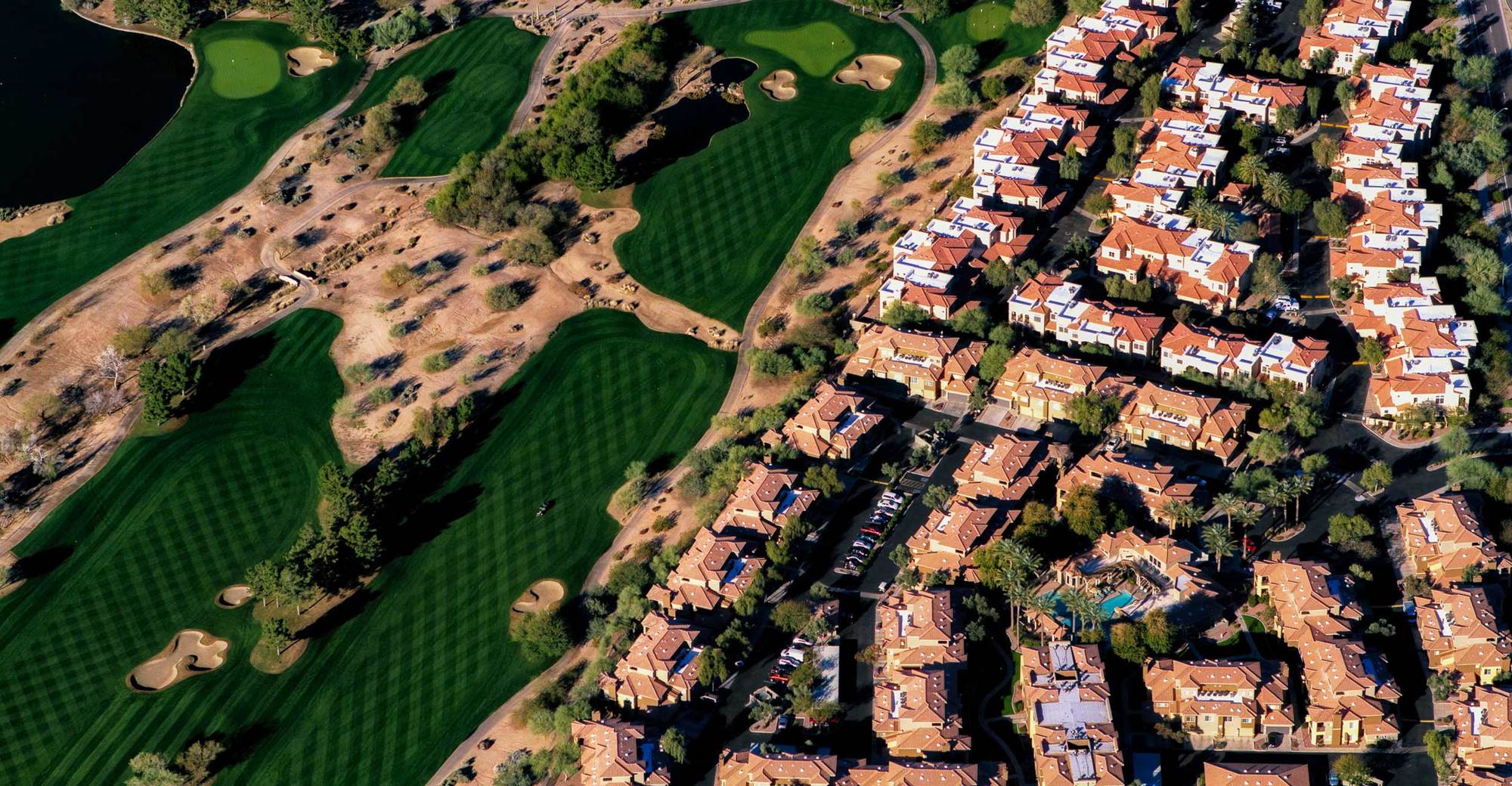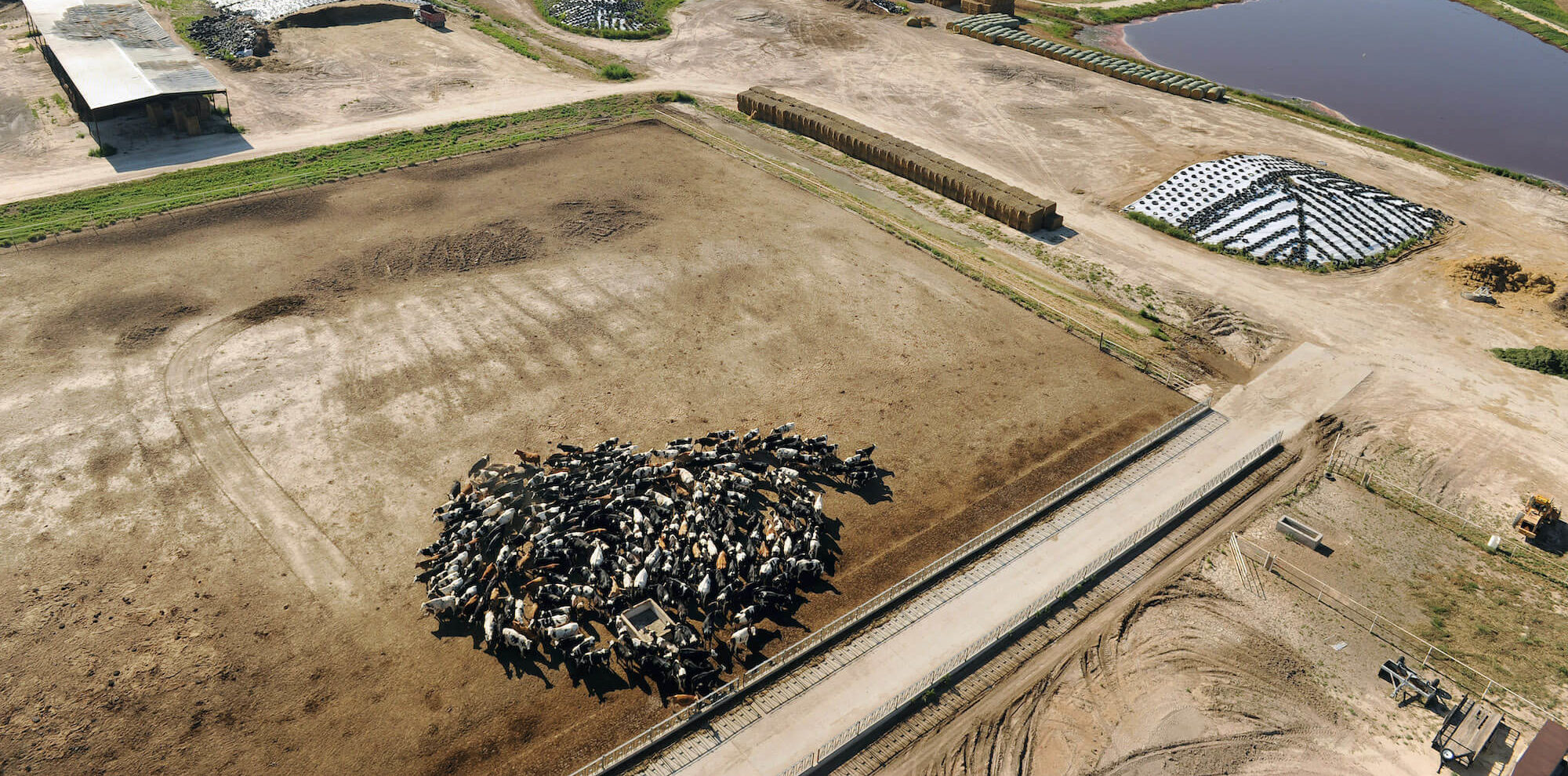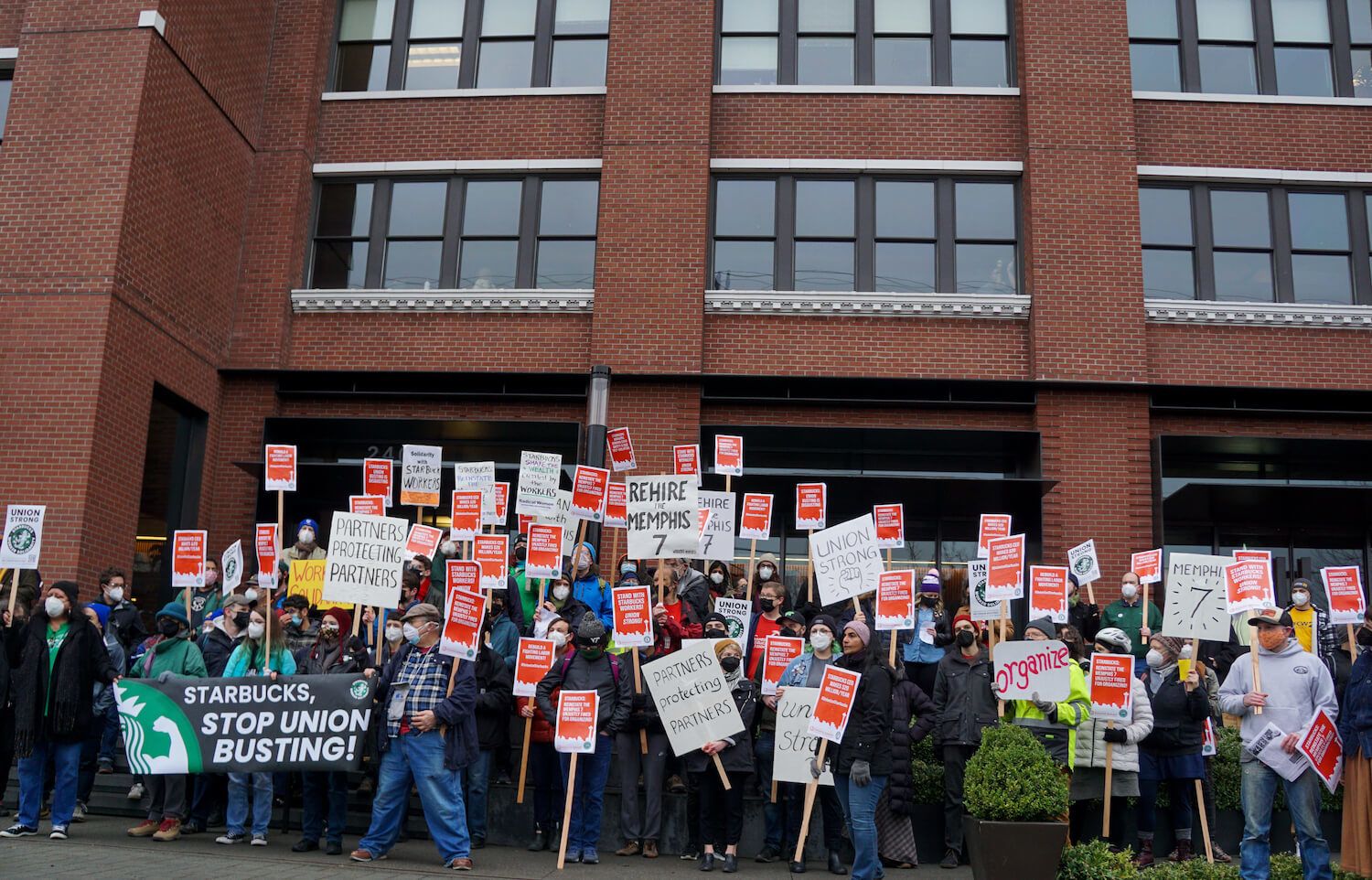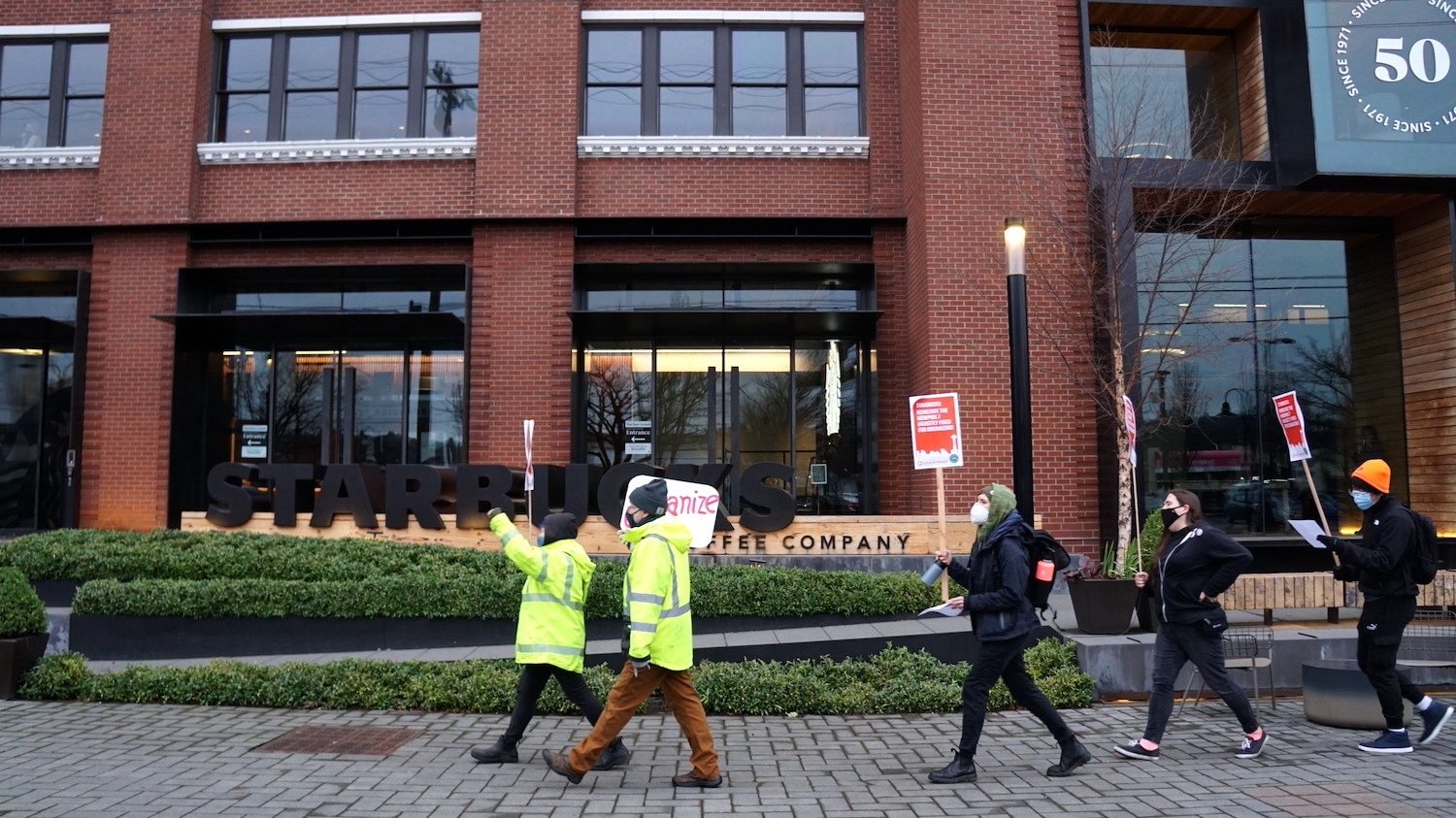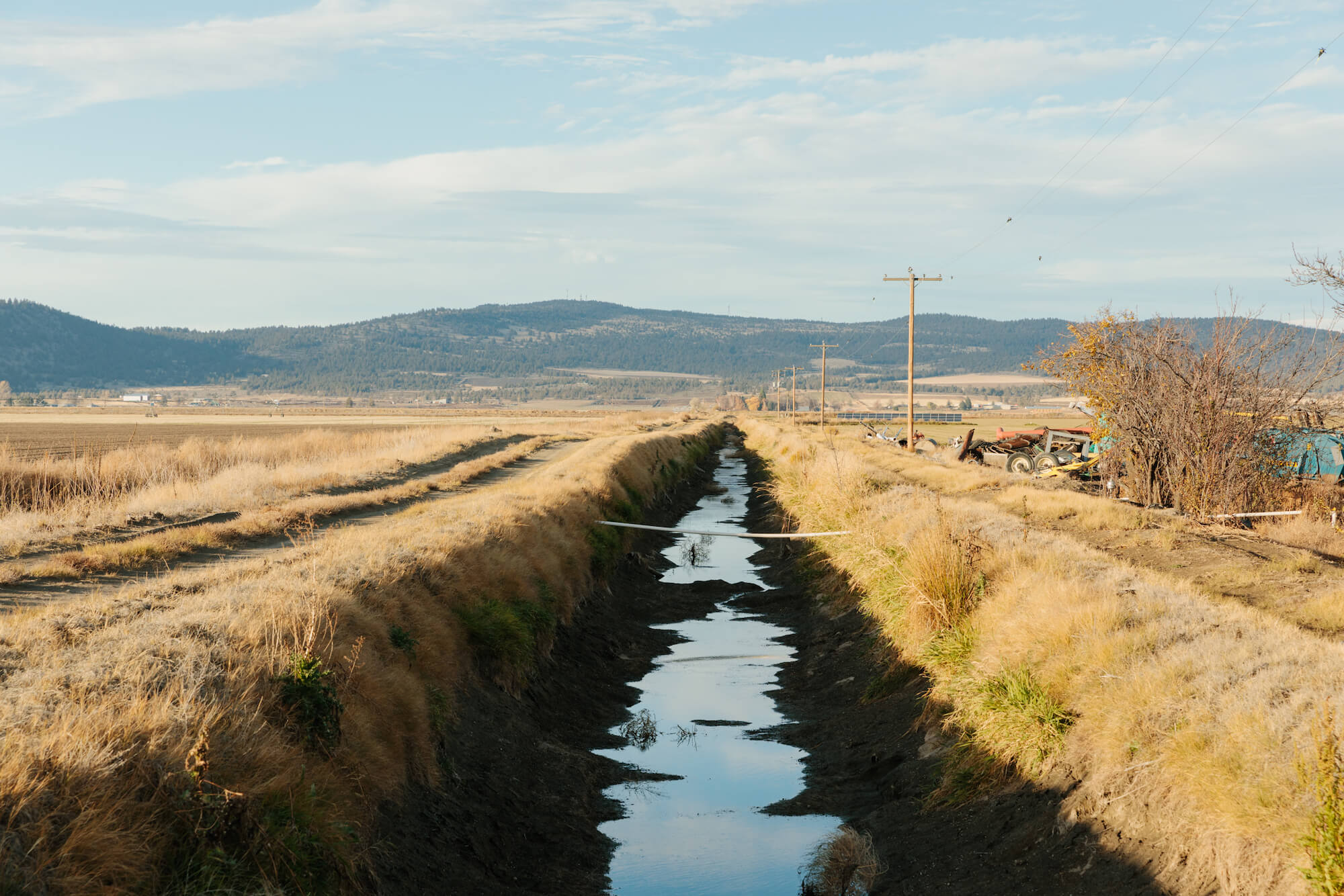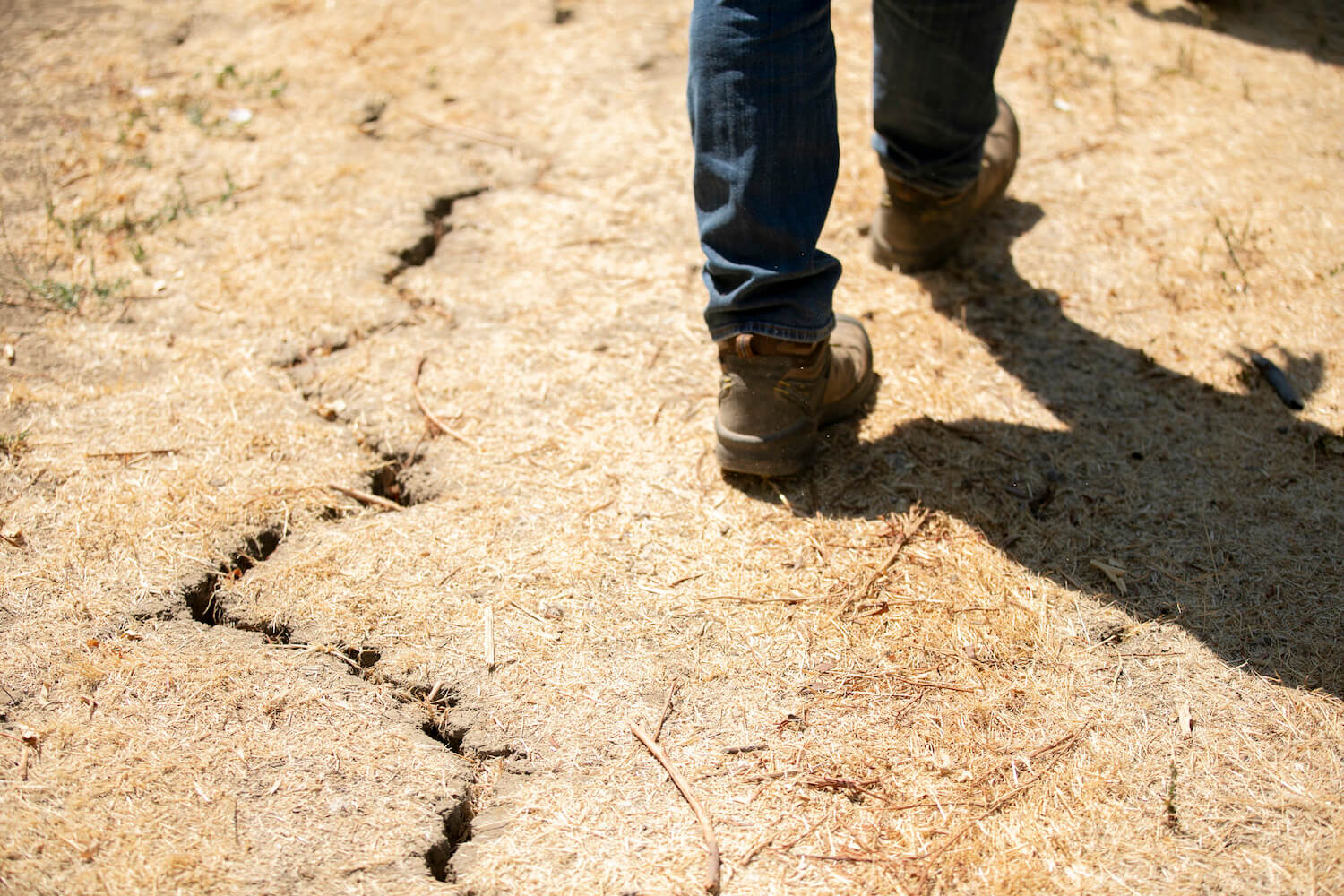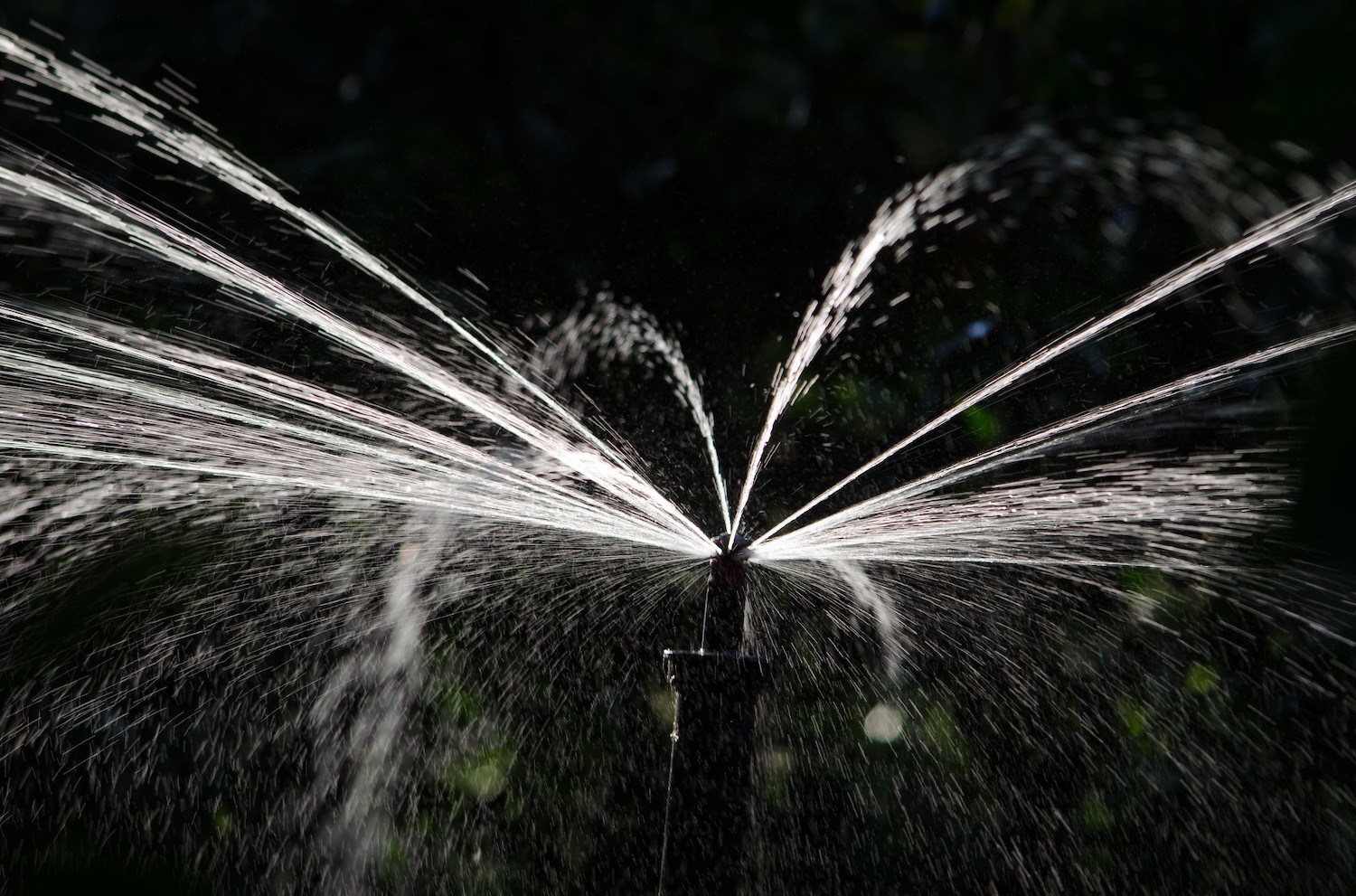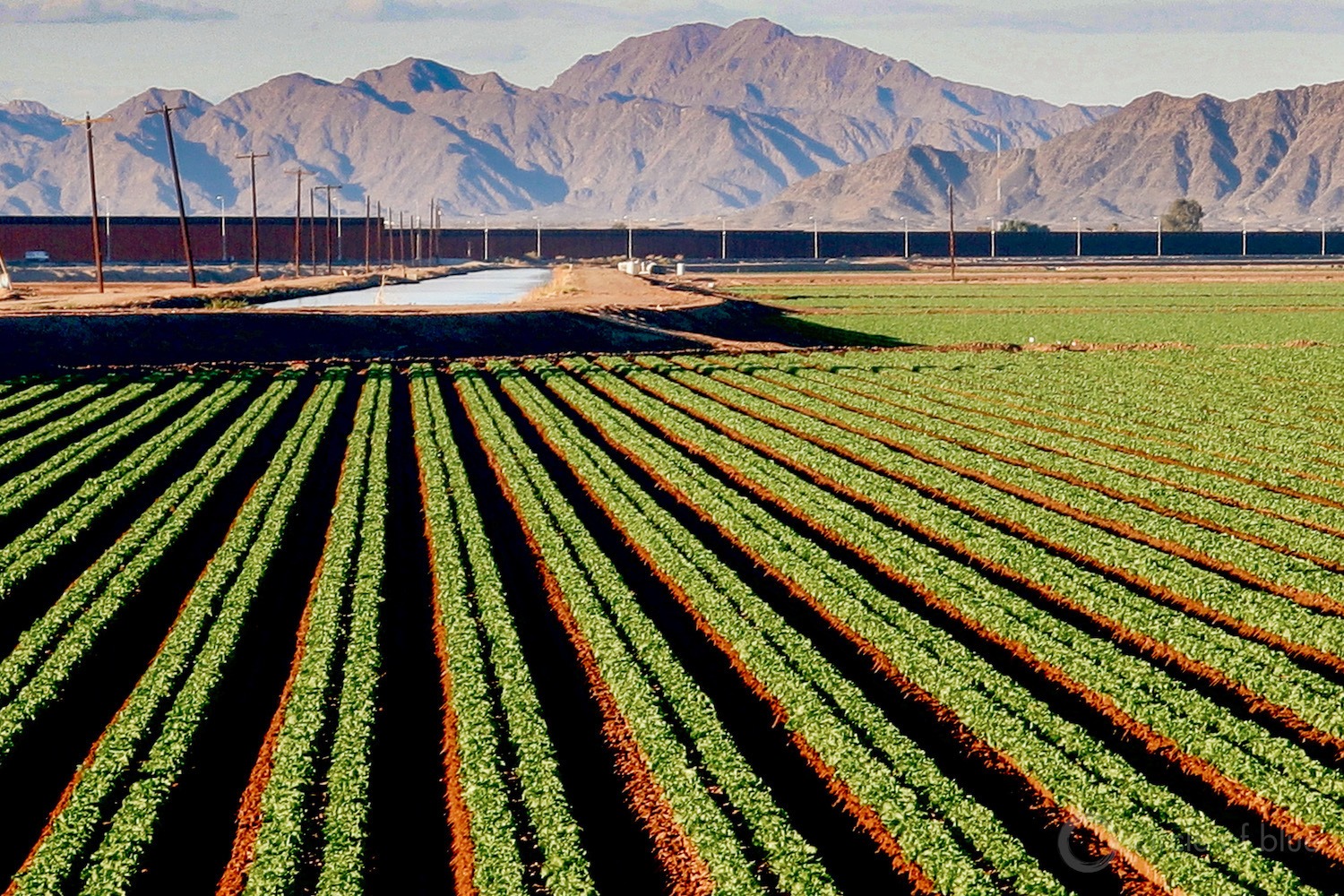
Keith Schneider / Circle of Blue
From the ongoing Tapped Out series on power and water justice in the rural West.
The Biggest Dry: Arizona, second of three reports. Read the first report here.
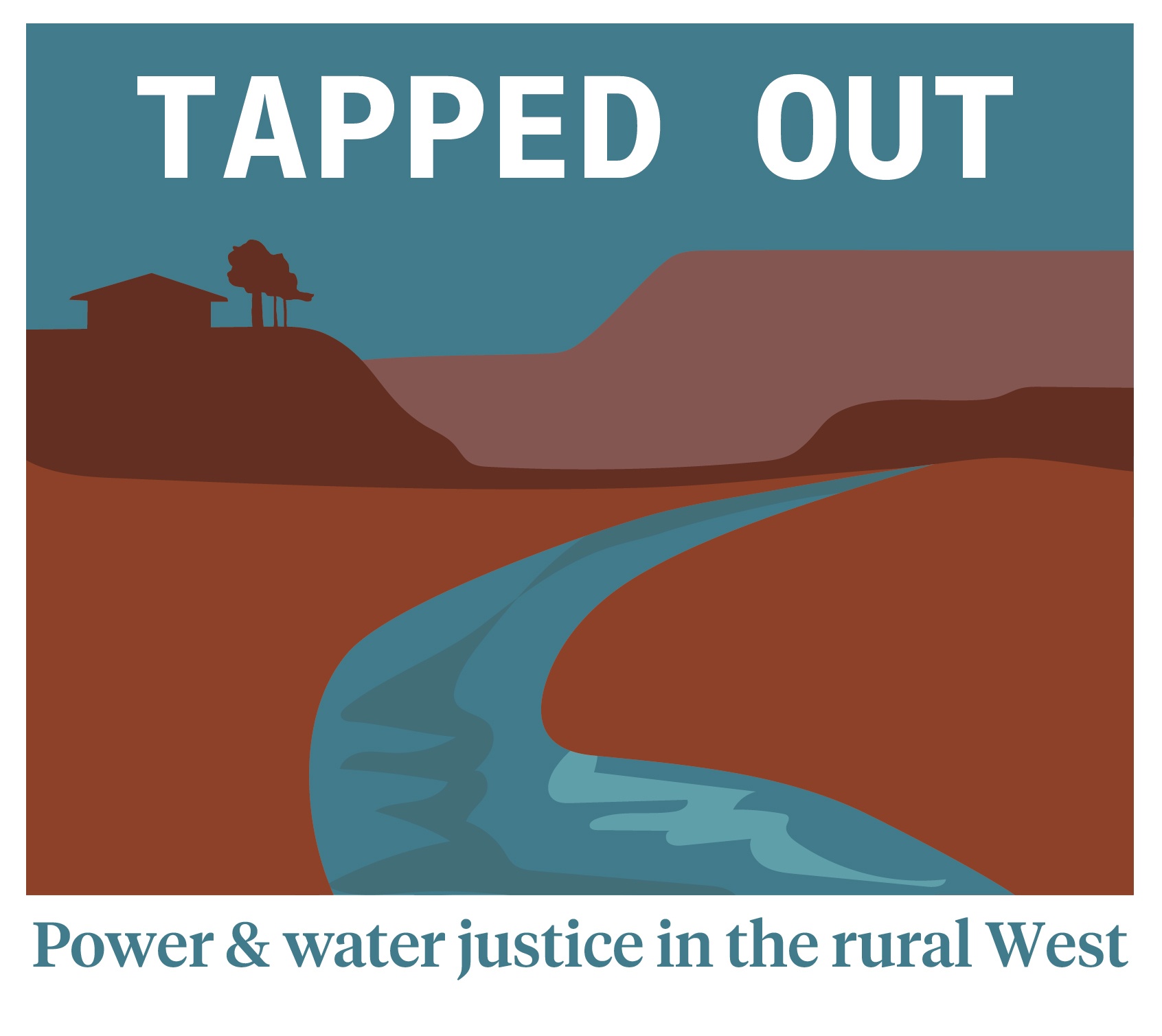
This piece from Circle of Blue is part of a collaboration managed by the Institute for Nonprofit News. For more stories in the Tapped Out series, click here.
Pictured above: Irrigation canals transport Colorado River water to state-of-the-art farm fields in Yuma, Az., a major supplier of winter leafy greens to U.S. markets.
WILLCOX, Ariz. – Nobody who knows Peggy Judd would mistake her for a political progressive.
At age 59, Judd is in her second term as one of three supervisors in Cochise County, a nearly 4 million-acre expanse of mesquite and cholla cactus, irrigated cropland, and pecan orchards silhouetted by towering mountains in southeast Arizona. Raised on a Cochise County farm and true to her allegiance to private property rights, Judd has no interest in hampering the development of this high desert county’s farms and ranches, which are an economic growth sector accounting for over $100 million in annual sales.
One more detail about Judd. Like many other Arizona Republicans, she is preoccupied by former President Donald Trump’s big lie that he won the 2020 election. County voters called for Judd’s resignation last year after she bragged on her Facebook page about marching on the Capitol during the January 6 “Stop the Steal” rally.
Yet when it comes to water in a county where groundwater is the sole source for irrigation and drinking, and where demand is racing ahead of supply, the boundaries of politics and ideology can change. Clear proof has emerged in recent years of the serious consequences of dropping groundwater levels in water-scarce Cochise County. A surge of aggressive groundwater pumping by new homes in the county’s southern region, along with recently arrived and thirsty livestock, pecan, and pistachio farms, has impaired the protected San Pedro River and caused irrigation and homeowner wells to go dry.
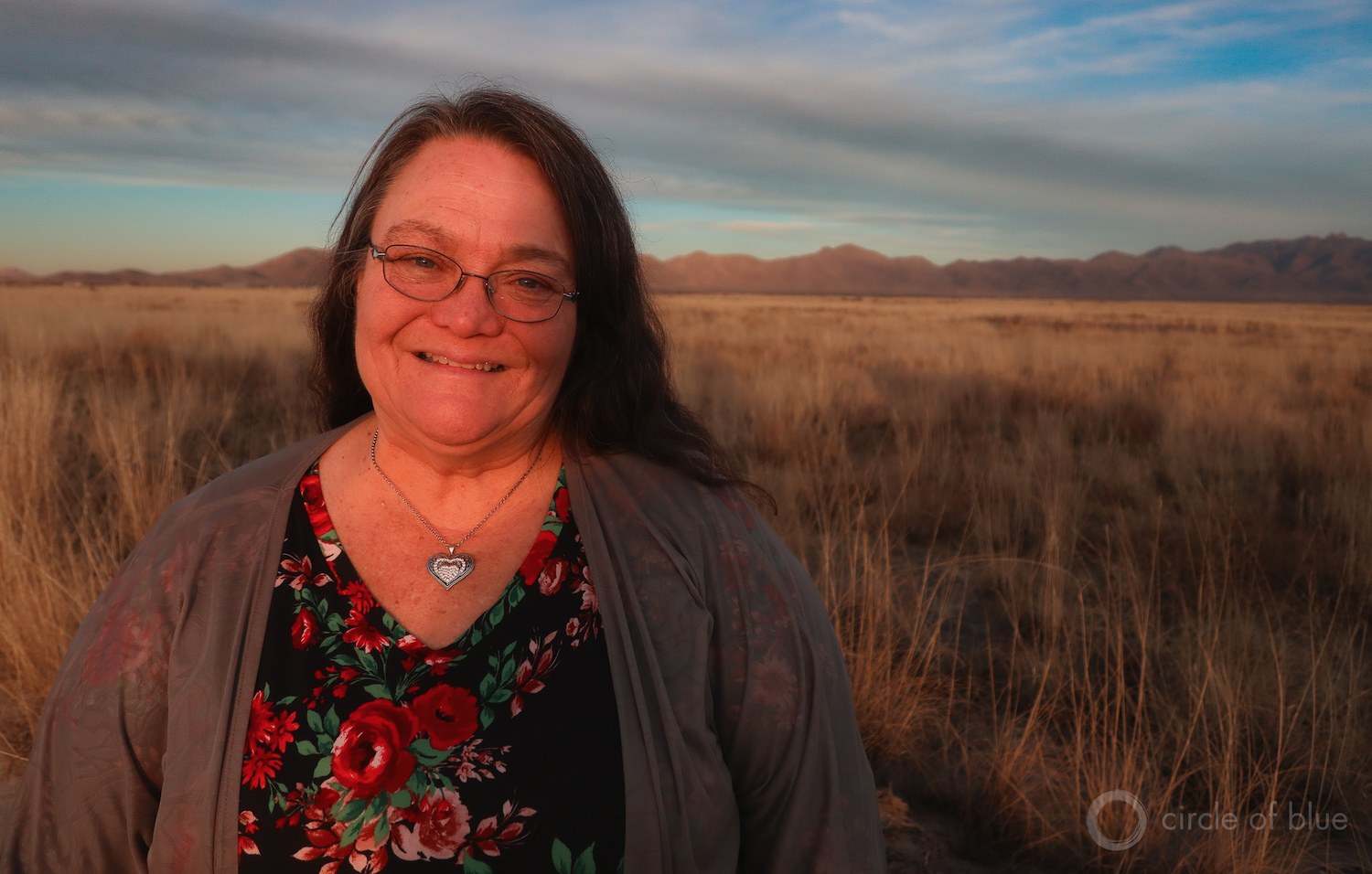
Peggy Judd, one of the three supervisors in Cochise County, where water scarcity is steadily becoming more apparent and more severe.
Keith Schneider / Circle of Blue
In order to develop acceptable responses, Judd finds herself surveying the region’s rugged political terrain of private interest, anti-government, free market zeal. Confrontations over water don’t always fit neatly into these spaces. Her assessment, swayed by conversations with constituents, is a more nuanced view of science, the public interest, and government’s role in brokering solutions.
She’s been active in organizing support for a new water district to supply piped water to over 1,000 homeowners south of Willcox, where water levels are falling and more than 100 drinking water wells are useless.
Reversing an earlier stance, she has also expressed interest in exerting some measure of local authority to oversee water use. “Six years ago I was kind of against it,” Judd said in an interview. “I have friends who farm, though. They convinced me that I needed to keep my mind open.”
Last year Judd joined her Democratic colleague on the Cochise board in aligning the county with the Department of the Interior and the Department of Defense – which manages an Army garrison at Fort Huachuca – to secure water supplies and improve the condition of the depleted San Pedro River near the border with Mexico.
A surge of aggressive groundwater pumping by new homes in the county’s southern region, along with recently arrived and thirsty livestock, pecan, and pistachio farms, has impaired the protected San Pedro River and caused irrigation and homeowner wells to go dry.
In approving the formal memorandum of understanding, Judd defied the other Republican supervisor, the county’s Republican leadership, and many of her friends who are suspicious of big government. “I’ve really been rubbed and rolled over the coals for voting to do things that are beneficial to the environment or beneficial to the people,” Judd said. “I’m told it’s not the government’s business. We shouldn’t be doing it. We shouldn’t be at the table on these things. I say we should.”
That the needle on Cochise County’s water supply meter is drifting away from full — actually slipping steadily closer to empty — is not in doubt. A 2018 study by the Arizona Department of Water Resources found that groundwater levels dropped 300 feet since 1950 in one basin. In other places it is declining 10 feet annually. According to the state, irrigation wells that cost millions of dollars are starting to be drilled to a depth of 2,500 feet.
Exactly what to do, whatever path is taken, is a journey across a desert of policy and practice that is getting steadily harsher as options become more expensive and political divisions widen. “Nothing happens without consensus, you know,” Judd said. “That’s what I’m trying to build on these water issues.”
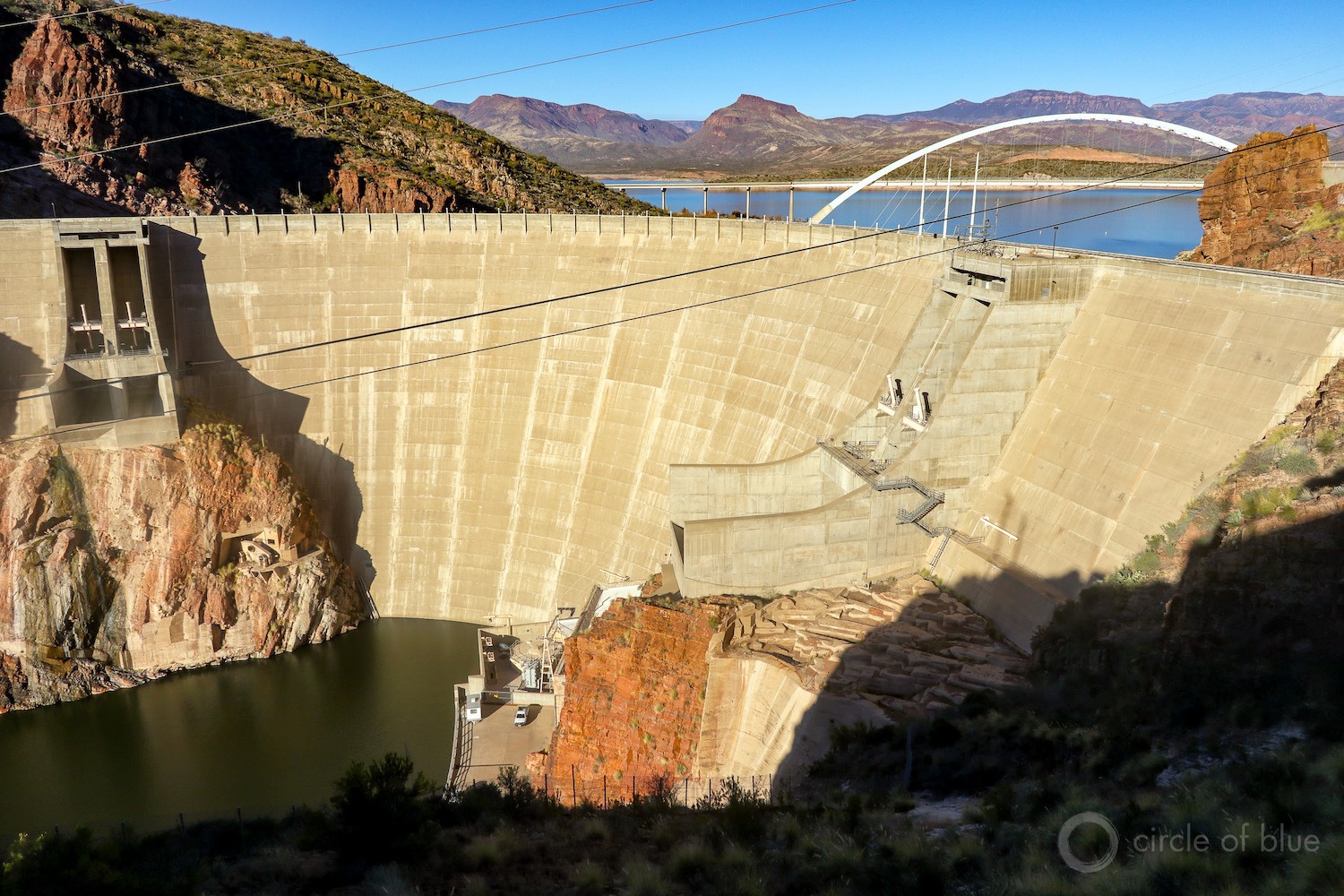
Arizona’s campaign to tame the fierce Southwest desert began in 1911 with the opening of Roosevelt Dam, the first of the West’s great federal dams, which stores Salt River water for Phoenix.
Keith Schneider / Circle of Blue
Though they make life in the Arizona desert more comfortable, air conditioning, private vehicles, and concrete highways are not the primary equipment that enabled one of history’s greatest desert civilizations. That distinction goes to the dams, reservoirs, and powerful pumps that secured access to the state’s surface and groundwater supplies. And to the aqueducts and irrigation canals that transported water to where it was needed.
Arizona’s impressive water infrastructure, most importantly, is the result of the disputes resolved and the consensus built on public policy, public investment, and oversight that unfolded in three overlapping policy-making eras in the 20th century.
A fourth era dominated by extreme heat and drought is underway to save what’s been built.
A great deal of Arizona’s groundwater is unusable because it contains high concentrations of salts and other impurities. And when it is pumped the land above often sinks, causing big cracks and deep trenches on the surface.
The short course goes like this. The first era, opening at the start of the 20th century and continuing until World War Two, secured surface water, which provides nearly 60 percent of Arizona’s water supply. Roosevelt Dam (1911), Coolidge Dam (1930), Bartlett Dam (1939), and four others were completed to store the waters of three rivers to serve Phoenix and surrounding farms. Hoover Dam was completed in 1935 to store the waters of the Colorado River in Lake Mead, the country’s largest reservoir. And in 1944 Arizona signed the seven state compact, initially negotiated 22 years before, to share the waters of the Colorado River and gain 2.8 million acre-feet annually of its flow.
The second era — call it the groundwater alert years — started in 1938 when Arizona appointed its first commission to study the increasing reliance on water stored in the state’s aquifers, a 1.2 billion acre-feet reserve, comparable to what Lake Ontario holds. Groundwater supplies 40 percent of Arizona’s water. But many desert aquifers are essentially a finite water source, and differ in depth and distribution. A great deal of Arizona’s groundwater is unusable because it contains high concentrations of salts and other impurities. And when it is pumped the land above often sinks, causing big cracks and deep trenches on the surface.
In 1945, two years after the Legislature funded a U.S. Geological Survey investigation of serious depletion, Arizona approved the first Groundwater Code that required irrigation wells to be registered. Three years later Arizona prohibited drilling new irrigation wells in ten designated Critical Groundwater Areas.
The third water supply era merged the surface water supply goals of the first era with the groundwater protection goals of the second. It opened in 1968 when President Lyndon B. Johnson signed the Colorado River Basin Project Act authorizing construction of the Central Arizona Project (CAP) by the U.S. Department of the Interior’s Bureau of Reclamation. The 336-mile aqueduct would eventually transport 1.5 million acre-feet of Colorado River water to Phoenix, Tucson, and Pinal County, the agricultural region that lies between them. Its primary purpose: supply the Phoenix-Tucson corridor and replace the groundwater being drained there with Colorado River water.
In 1979, six years into its construction, the aqueduct project came under scrutiny by the Carter administration, and not only because of its multi-billion dollar cost. Unconvinced that the project would actually lead to less groundwater pumping, the Interior Department threatened to shut down construction of the aqueduct unless Arizona adopted a more stringent groundwater code. The warning galvanized then Gov. Bruce Babbitt and the Arizona Legislature to enact the 1980 Groundwater Management Act, a regulatory regime to reduce groundwater pumping. It also established a new state agency, the Arizona Department of Water Resources, to administer the law.
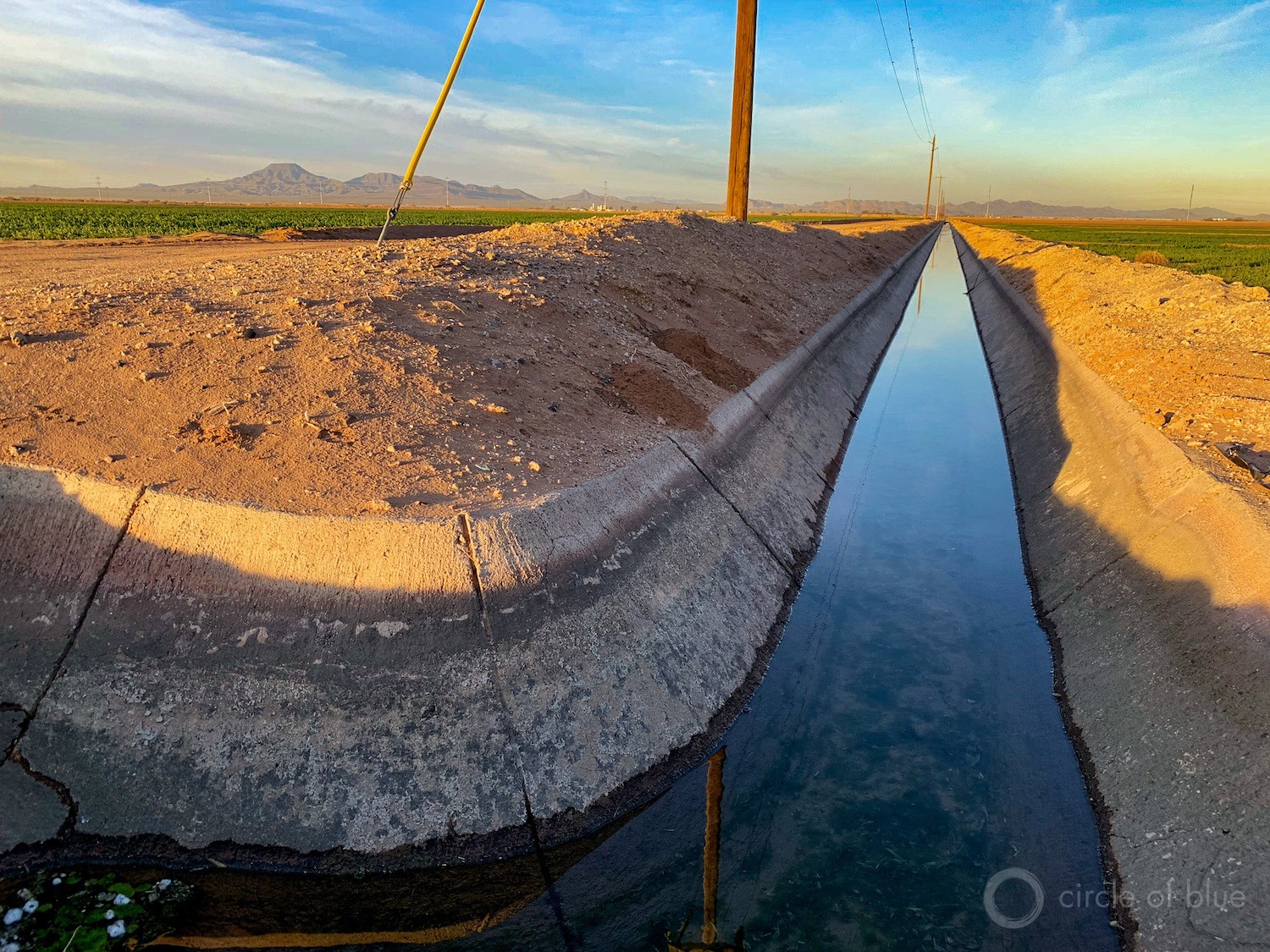
An irrigation canal in Pinal County. This is the year the limitations of Arizona’s 20th-century engineering and policy innovations are readily apparent. Groundwater withdrawals in and outside the AMAs are increasing.
Keith Schneider / Circle of Blue
Essentially, the statute had three primary objectives. First, it halted expansion of irrigated farmland in Pinal County and regulated groundwater use in three other designated “active management areas” (AMAs) – Phoenix, Tucson, and Prescott. A fifth AMA in Santa Cruz, south of Tucson, was established in 1994.
Second, it set a 2025 goal for the Phoenix, Tucson, and Prescott AMAs to put as much water back into aquifers through artificial and natural recharge as was being withdrawn, a groundwater supply balance that lawmakers called “safe yield.”
Third, it required developers to prove they had a 100-year assured supply of water before they c0uld sell subdivision lots. The law set a 1995 deadline for the Arizona Department of Water Resources to promulgate rules to meet the requirement.
As that deadline approached and demand for new housing mounted, the Legislature jumped in to help a powerful constituency. Subdivision builders in undeveloped parts of the Phoenix and Tucson AMAs had no access to water from the Central Arizona Project and were having trouble meeting the 100-year assured water supply requirement. They pressed the Legislature to make it easier to get the water they needed.
In 1993, the Legislature responded by establishing the Central Arizona Groundwater Replenishment District, a project administered by the operators of the Central Arizona Project that is required to replenish water in regional aquifers comparable to the amount of groundwater being pumped out for new developments. In most cases the replenishment source is the Colorado River.
With surface and groundwater supplies more secure than ever before, Arizona raced to the head of the national pack in economic growth, housing starts, and new jobs. In 2000, Arizona counted 4.8 million residents, 70 percent more than in 1980. The state has added 2.3 million more residents in the two decades since.
Phoenix and Tucson became magnets for sun seekers. Yuma, along the banks of the Colorado River in southwest Arizona, developed into the country’s winter leafy green capital. Sedona, near the Grand Canyon, surfaced as a nationally known retreat for spiritual healing and red rock adventure. Groundwater levels, particularly in Pinal County, actually started rising.
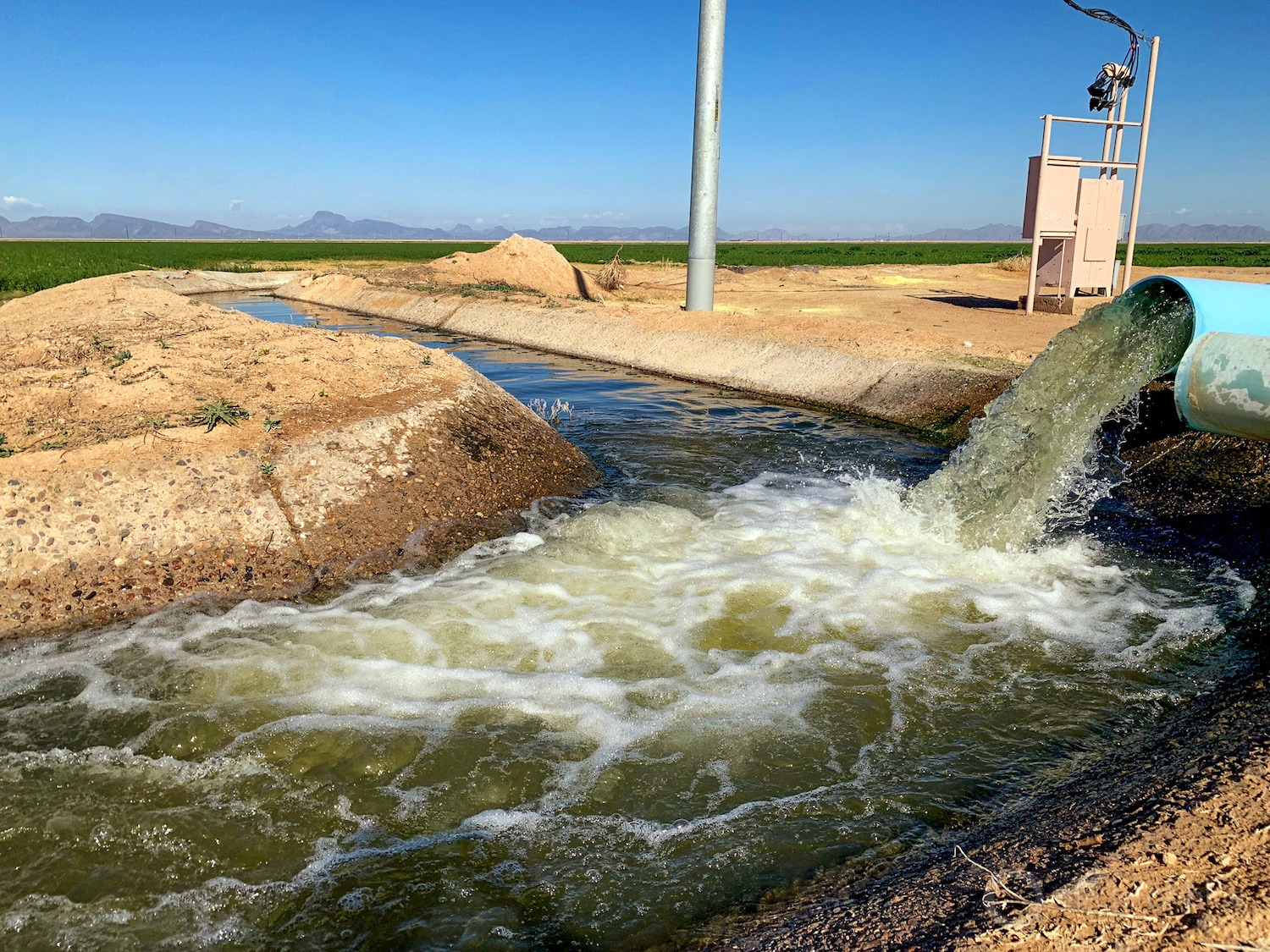
As water supplies from the Colorado River drop the demand for Arizona’s finite reserves of groundwater are increasing. Here, pumping fills an irrigation canal near Gila Bend, Ariz.
Keith Schneider / Circle of Blue
Earth pushes back
That momentum carried into the first decades of the 21st century even as a new era of water supply and demand opened. Call it the years of survival, when Earth’s power to heat and dry the state began to overwhelm the achievements of the first three eras, draining surface water supplies, increasing reliance on finite groundwater reserves, and causing water supply stress in almost every region.
No consensus has yet developed for its opening date, though several are candidates.
It could be 2000, the year the Southwest’s megadrought started and Lake Mead began its bathtub ring decline. It could be 2007, the year the Interior Department set guidelines on cutting Colorado River water supplies to Arizona if Lake Mead water levels continued to drop.
Or it could be August 16, 2021, the day the U.S. Department of the Interior issued the first-ever water shortage declaration on the Colorado River. Arizona’s 2022 supply of Colorado River water was cut 512,000 acre-feet — a third of the water typically transported in the CAP canal — causing farmers in Pinal County to fallow 30 to 40 percent of their land and sustain $100 million in lost income.
To calm public anxiety, governments and water authorities stressed that the shortage declaration came as “no surprise.” It nevertheless produced an ominous mark on the graph of Arizona’s water supply and use. This was the year that the lines for rising municipal and industrial demand for water and falling supplies crossed, confirming the extent of water stress across Arizona.
In northern Arizona’s Mohave County, two studies found that at current rates of use the region’s aquifer would be empty before the end of the century. According to water hauling companies, groundwater pumping dropped aquifers so low in the Chino Valley (near Prescott) that thousands of residential wells have gone dry.
“You can’t grow and grow and grow on these far-flung lands on groundwater, have agriculture just continue to be such a dominant water user, and put industries anywhere you want. You have to be smarter. We have to change how we grow.”
Flagstaff, close to the Grand Canyon, has proposed building a 40-mile-long, $200 million-plus pipeline to tap a distant aquifer beneath a ranch. Authorities in Scottsdale, reacting to the federal water shortage declaration and requirements of its own drought contingency plan, set a December 31, 2022, deadline for shutting off access to a city-owned depot used by tanker trucks that deliver drinking water to over 500 homeowners in the Rio Verde Foothills north of the city.
Phoenix, Tucson, and Prescott are withdrawing more groundwater than they are replacing and will not meet the 2025 “safe yield” goal, according to a 2021 study by the Arizona State University’s Kyl Center for Water Policy.
“We’ve reached that point. You can’t have it all,” said Kathleen Ferris, a senior research fellow at the Kyl Center who helped write the 1980 groundwater law and co-authored the 2021 study. “You can’t grow and grow and grow on these far-flung lands on groundwater, have agriculture just continue to be such a dominant water user, and put industries anywhere you want. You have to be smarter. We have to change how we grow.”
There is not yet consensus on that assertion in official Arizona. State water authorities point to data that shows Arizona’s water use is 7 million acre-feet annually, which is 30 percent or 3 million acre-feet less than in 1980 when the state had 4.5 million fewer people. A sizable share of that reduction, though, is the 200,000 fewer acres that Arizona farmers are no longer irrigating.
What is clear is that 2022 is the year that the limitations of Arizona’s 20th century engineering and policy innovations are readily apparent. Groundwater withdrawals in and outside the AMAs are increasing. Water supplies from the Central Arizona Project, a paragon of design and industrial competence built to reliably substitute surface water for groundwater and solve water scarcity in one of the nation’s fastest growing states, became unreliable.
“Arizona has come to this moment to more deeply acknowledge that groundwater is finite. But that is happening without the comfort of a new supply,” said Amy McCoy, a research scientist and water supply consultant who’s worked in Arizona and Colorado. “On the contrary, it’s happening with dramatic decline in Colorado River supplies, and in snowpack, and in water recharge in general.
“That is where the state is at right now,” McCoy said. “We have one cup of tea. What are we going to do with it?”
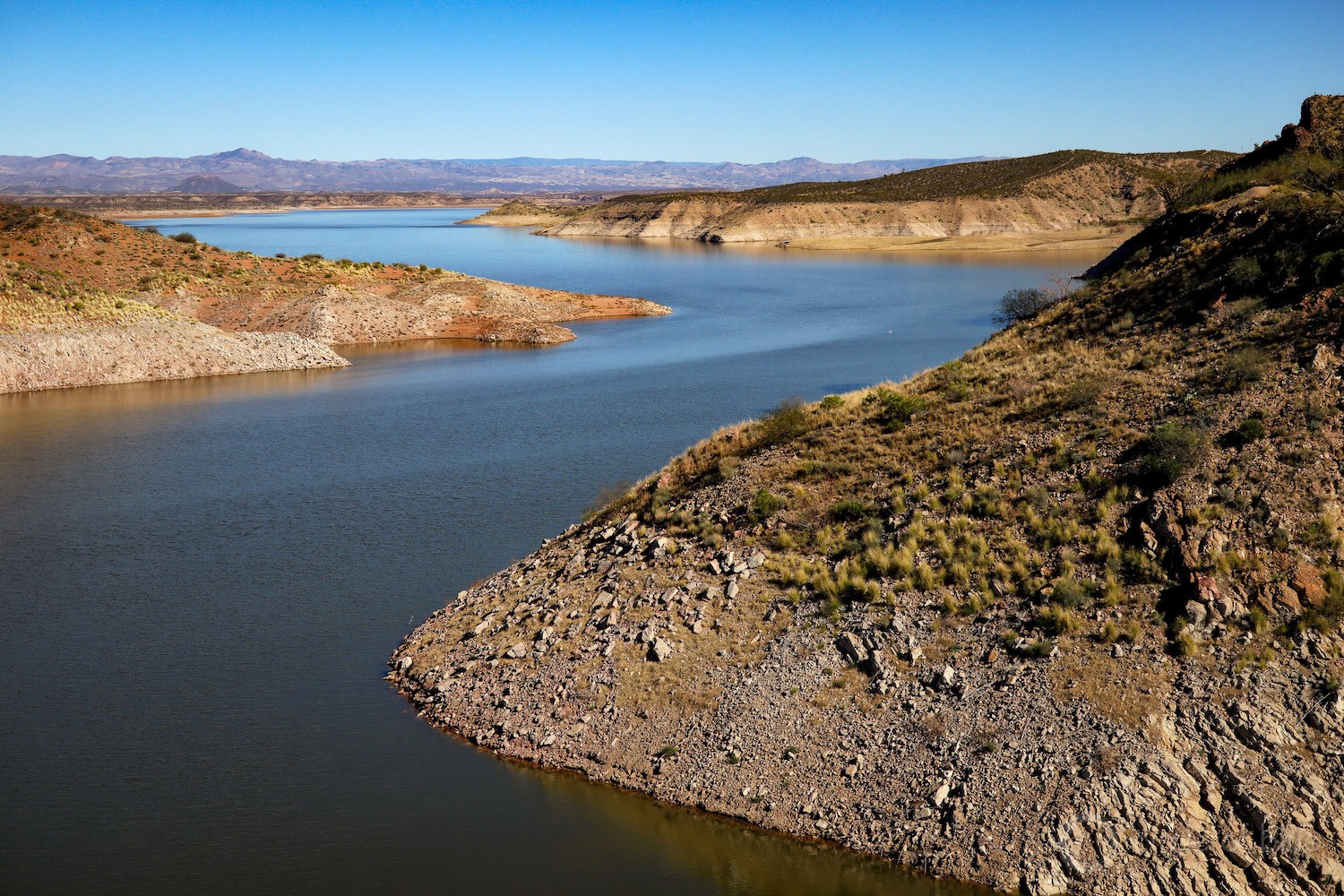
Climate change is intensifying heat and drought in the mountains east of Phoenix and has left San Carlos Lake, formed by 92-year-old Coolidge Dam, 97 percent empty.
Keith Schneider / Circle of Blue
Responses
That is an acute public interest challenge, just the kind that in previous eras was answered by federal, state, and local leadership sufficiently skilled in sorting out the details, negotiating differences, and reaching consensus on responses. That capacity is weaker now as fixes become more complex.
The lift is especially heavy due to the limitations of the state Legislature — one of the forums that Arizona has traditionally turned to for help — which is controlled by Republicans.
Last year, the state Republican Party and many of its elected lawmakers were primarily intent on conducting an audit and overturning the results of the 2020 election, the first loss in Arizona by a Republican presidential nominee since 1996. This year the party’s legislative focus is to game the system. In January, Republicans introduced 100 bills devoted to making voting harder. They include measures to stop early voting, end mail-in ballots, and enact other restrictions to curb participation.
Even without significant legislative attention, a number of water-related ideas currently command an audience. A proposal to reduce groundwater demand that is supported by city and county authorities is nonetheless experiencing turbulence in the Legislature. In Mohave County, which depends on aquifers for all of its water, and where big pecan farms are blamed for dropping groundwater levels 200 feet over the last decade, officials support changing state law to allow local oversight of groundwater withdrawals.
State Rep. Regina Cobb, Republican chair of the House Appropriations Committee and a resident of Kingman, the county seat, has introduced legislation every year since 2017 to accomplish that objective. She’s been rebuffed four years in a row. This year, her last in the House, she’s asked Republican House Speaker Rusty Bowers for help. The prospects for passage are uncertain.
“I’ve been told water is a private property right and leave it alone. My thought is it’s a private property right until it affects everyone in the county, and everyone in the state. Then it’s no longer private. It’s a resource all of us need.”
“I’ve been told water is a private property right and leave it alone,” Cobb said. “My thought is it’s a private property right until it affects everyone in the county, and everyone in the state. Then it’s no longer private. It’s a resource all of us need.”
Another group of responses to water scarcity in Arizona is aspirational. Republican Gov. Doug Ducey, reflecting the popular views of industry, real estate, and the farm community, wants to develop new water supplies. Ducey budgeted $160 million last year to study the potential for what he and others call “augmentation.” That term reflects a number of approaches like building desalination plants, designing homes, streets, and parks to capture and store stormwater, and increase supplies from recycled wastewater.
The latter already accounts for over 500,000 acre-feet of water available for landscaping, irrigating golf courses, and cooling Palo Verde, the state’s lone nuclear generating station. Ducey wants more. It could come from California.
Arizona and CAP are investing $6 million in a $30 million, three-year feasibility study by the Metropolitan Water District in Los Angeles that could lead to construction of a $3.4 billion wastewater recycling plant capable of producing 168,000 acre-feet annually. Instead of being flushed into the Pacific, the water would be available for the dryland metropolises. The new supply would offset some of the 4.4 million acre-feet that California is entitled to withdraw annually from the Colorado River.
The new recycled supply also could provide more water for Arizona and other Colorado basin states, or it could be used to keep water levels in Lake Mead high enough to prevent more emergency shortage declarations that come with even larger cuts in the state’s surface water supply.
This year Ducey proposed establishing a new state agency, the Arizona Water Authority, to find new sources of water and called on the Legislature to approve $1 billion for it to spend. Ducey is particularly intent on building a desalination plant capable of delivering 250,000 acre-feet of water annually. The proposed location is the Gulf of California in Mexico. A plant of comparable size in Saudi Arabia took three years to build and opened in 2014 at a cost of $7 billion.
Given the 10-year to 20-year timeline to plan, design, finance, and build major infrastructure projects, including the necessary pumping stations and pipelines for a Mexico-based plant, the price would be much greater. The cost of an acre-foot of water would be thousands of dollars.
Nor is it clear where the new supply will go. Given the location, the new supply could go to Mexico to offset the 1.5 million acre-feet of Colorado River water that Mexico has been entitled to since 1944. In that case it would be a cross-boundary trade. Mexico’s allotment of Colorado River water would drop by the same amount that Arizona supply increases.
Whatever occurs, if the plant is built, Arizonans will almost certainly spend considerably more for water than they do today.
An even more frantic and fanciful idea, offered by Tim Dunn, a Republican House member from Yuma, is making its way around the state Capitol: somehow capturing water from the Mississippi River for use in Arizona. Such a project would rival China’s South-North Water Transfer Project — the construction of three immense water pipelines for siphoning water from the Yangtze River and transporting it 890 miles north to Beijing.
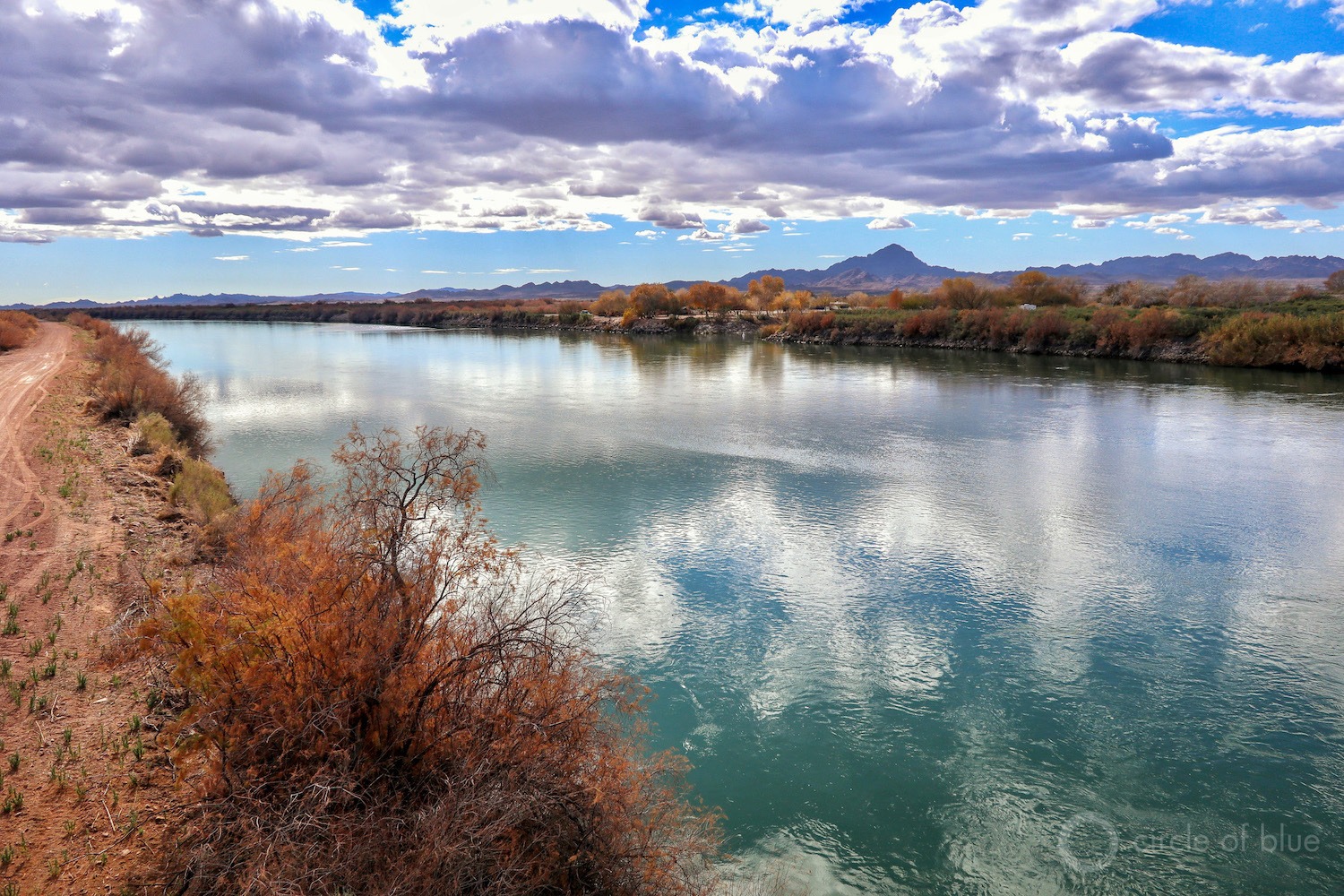
The Colorado River near Cibola, Ariz. A plan to transport river water from here to Queen Creek, a fast-growing Phoenix suburb, is supported by the state Department of Water Resources and protested by Colorado River counties.
Keith Schneider / Circle of Blue
The federal government contemplated a similar and ultimately unsuccessful diversion from out-of-state basins in the 1960s when it proposed diverting water from rivers in the Pacific Northwest to supply the Colorado River.
And in 1968, following a deep drought and two comprehensive federal and state studies that projected severe deficits in water supply, Texas water authorities proposed withdrawing 12 million acre-feet of water each year from the Mississippi River near New Orleans. The proposal called for the new supply to be transported through a modern day Roman Empire-scale network that crossed Louisiana, spanned much of Texas, and encompassed 1,000 miles of concrete-lined canals, 67 new reservoirs, and electricity-generating stations to power hundreds of pumps. Voters rejected the idea principally due to the cost — $74 billion in current dollars.
A third group of proposed water supply solutions in Arizona is changing how existing supplies are allocated and transported around the state, which essentially means reducing agriculture’s share of available water. “The economic reality is that irrigated agriculture uses 70 percent of Arizona’s total water use for 2 percent of the state’s total G.D.P.,” said Bruce Babbitt, the former governor. “What we ought to be doing is setting up a regulatory system which provides incentives to move a small proportion of that irrigated agricultural use into urban industrial use. If you reduce the agriculture footprint in the state by 10 percent, that would free up nearly a million acre-feet of water, which would easily be enough for the entire foreseeable future for urban industrial use.”
“What we ought to be doing is setting up a regulatory system which provides incentives to move a small proportion of that irrigated agricultural use into urban industrial use.”
Babbitt’s idea is gaining traction. The Colorado River Indian Tribes, who farm 80,000 irrigated acres, have rights to more than 600,000 acre-feet of Colorado River water. The tribe is seeking federal legislation to allow it to market some of its allocation to users outside of reservation lands, located on the banks of the river.
South of Phoenix, the Gila River Indian Community farms 35,000 acres and is already marketing some of its water entitlement, which is more than 650,000 acre-feet annually. Since 2016, the tribe has kept 370,000 acre-feet in Lake Mead to help slow the reservoir’s decline. And though the August 2021 shortage declaration cut its Colorado River water supply by 41,000 acre-feet, the tribe agreed to leave almost 130,000 more acre-feet in Lake Mead this year, receiving nearly $36 million dollars from the state and federal government.
Arizona’s groundwater law allows for water from several aquifers in rural farming counties west of Phoenix to be tapped and moved into the metropolitan area. But moving water from a rural region to the Phoenix metro area also has ignited fierce opposition. Queen Creek, a fast-growing Phoenix suburb, purchased a small farm in Cibola, along the Colorado River, to gain access to 2,000 acre-feet of water annually to serve residents and businesses. The transfer, supported by the state Department of Water Resources, was protested by citizens and elected leaders from Colorado River counties, among them Rep. Cobb, who has introduced the groundwater oversight bills.
The regulatory process also is an impediment. Most basin-to-basin water transfers would require transport in the Central Arizona Project canal, requiring approval by the Department of the Interior. The department is reviewing the Queen Creek transfer.
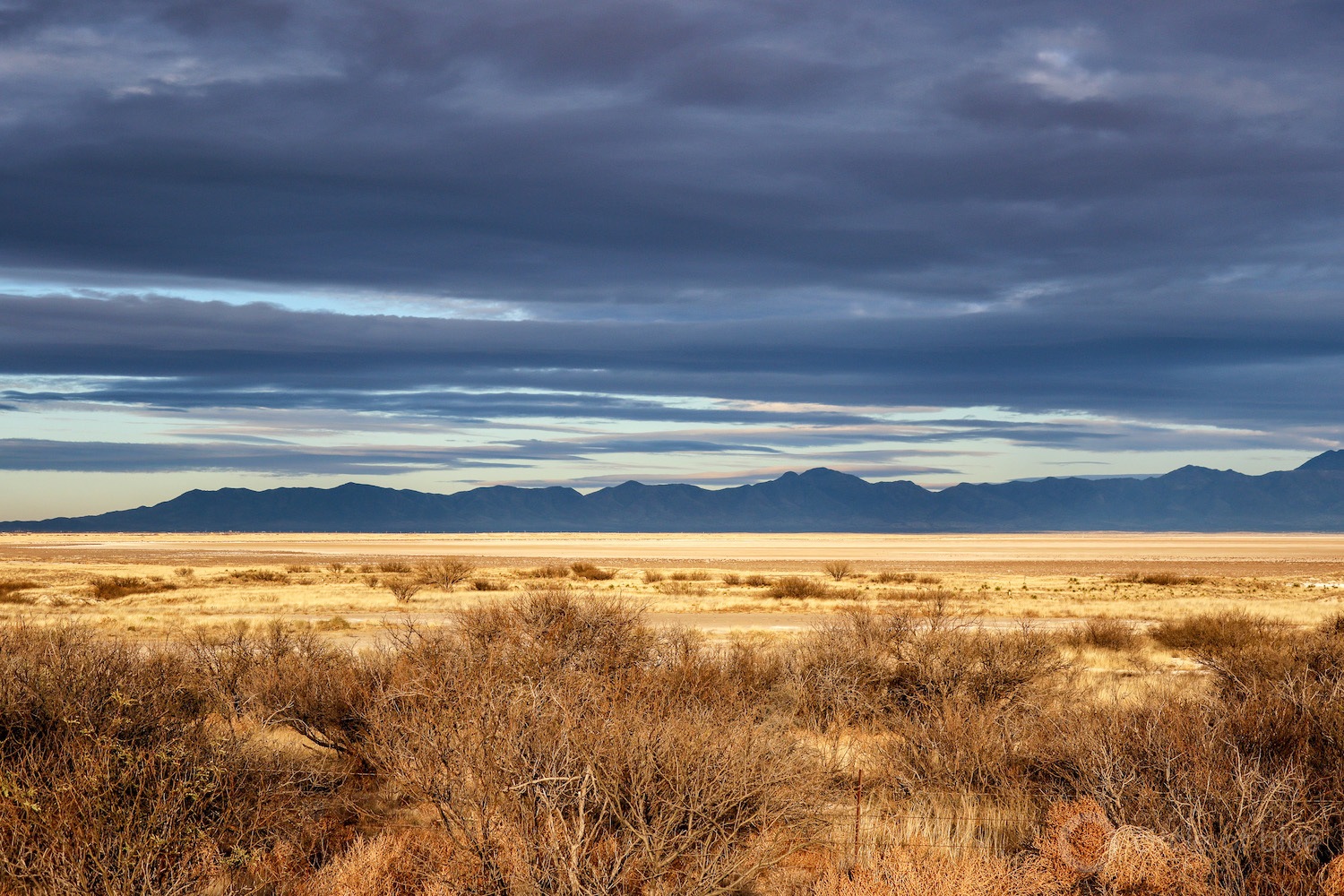
A surge of groundwater pumping by thirsty livestock, pecan, and pistachio farms has caused irrigation and homeowner wells to go dry in Cochise County, in southeast Arizona.
Keith Schneider / Circle of Blue
A reckoning in Cochise County
On a temperate January day, as the sun began to set on the dark peaks west of Willcox, Peggy Judd explained the intricacies and difficulties of securing Cochise County’s groundwater supplies.
The dropping water table, which appears to be principally due to aggressive pumping for irrigation, is causing subsidence and opening deep fissures in the earth, some of which are damaging highways. But in a county that has been losing population for most of the century, and where old downtowns are a collection of empty and ragged structures, agriculture is attracting new jobs and tens of millions of dollars in investment.
“It’s hard. We all just need to stop arguing,” Judd said. Then she grabbed her phone and started dialing. “I need you talk to this guy,” she said. “Get his thoughts.”
“This guy” is Calvin Allred who, at age 75, has spent most of his adult life as a lawyer in Willcox, where he moved in 1978 and represented many of the county’s farmers and ranchers. Raised on a farm, Allred returned to active agriculture production in 2003 when he started growing 800 acres of pecans. Two instincts guided his farming principles. First, Allred recognized that pecans were poised for growth in Arizona’s productive farm sector. Cochise County, with 1,100 farms and nearly a million acres of farmland, was a sensible place to settle.
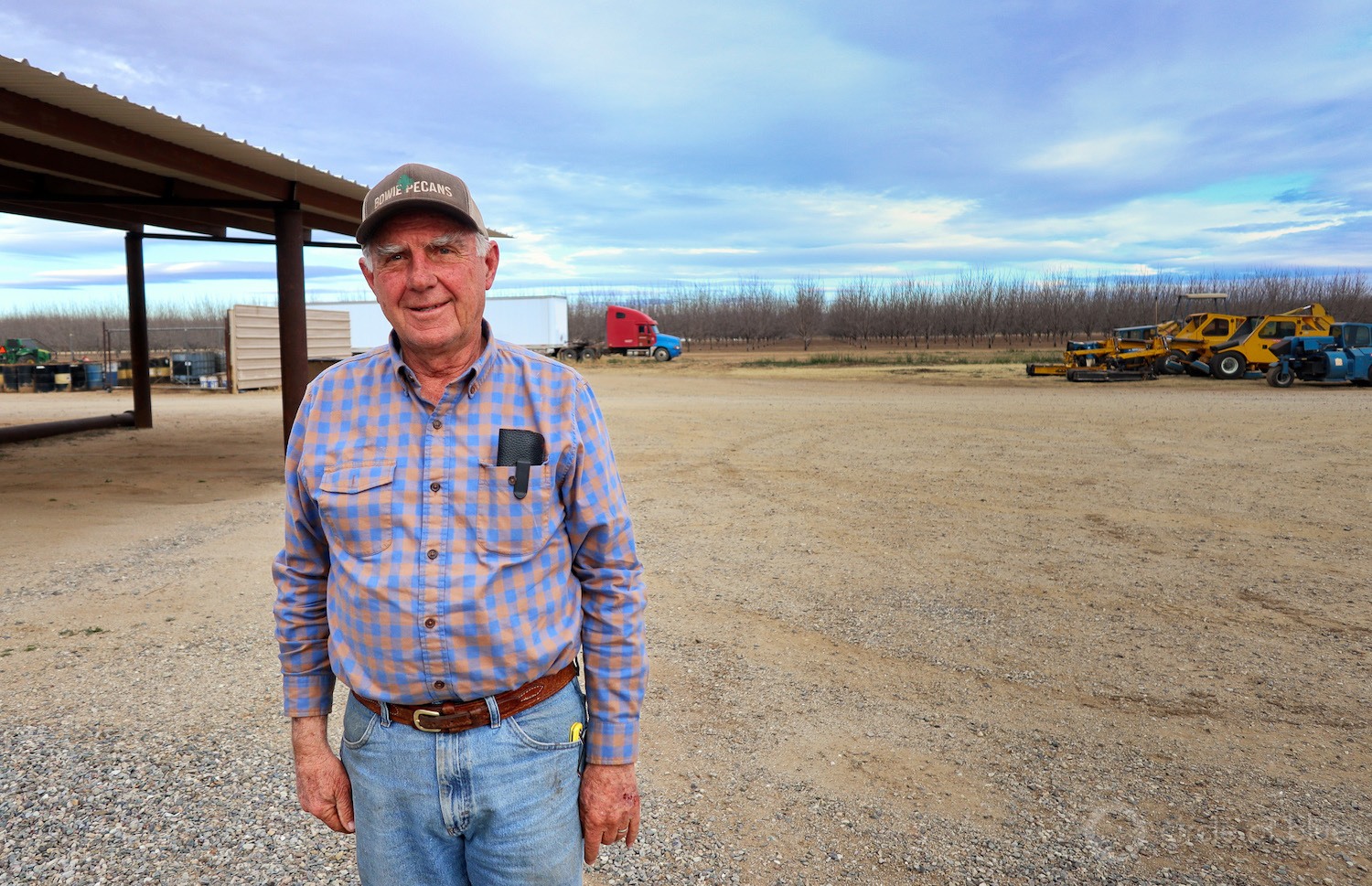
Calvin Allred raises 800 acres of pecans on a Cochise County farm where groundwater levels are dropping 5 feet a year.
Keith Schneider / Circle of Blue
His second instinct was the certainty that in the hard work of drilling wells, planting trees, and raising food, regulation was not needed since Cochise County seemed to have water and land in abundance. “The agricultural footprint then was sustainable,” he said.
Though Allred did not know it at the time, starting his farm in Cochise at the dawn of this century coincided with a boom in the county’s farm sector. Cochise is now one of the largest producers of pecans and pistachios in Arizona, which is a $52 million crop for the state. The same virtues that lured Allred — land and groundwater — also attracted other big water-thirsty farms, including a Minnesota-based dairy company that built one of the largest agriculture operations in the Southwest. Riverview LLP’s two dairies in Cochise manage a herd of 120,000 animals, and grow feed on 39,000 irrigated acres. The dairies and the irrigated fields, according to a company spokesman, draw 110,000 acre-feet of water annually from the Willcox aquifer, which is close to what Tucson’s residents use.
Not surprisingly, drinking water wells have gone dry for homes closest to the dairy. Vance Williams, a disabled Air Force veteran who lives on $1,200 a month, owns one of the wells. It dried up a year ago, forcing him to spend $1,600 he could ill afford on a 2,500-gallon water tank and pump. He pays $100 a month for 1,500 gallons hauled to his tank by truck. His life, never easy, has become much more turbulent.
“We’re really careful about what we use,” he explained while standing in front of the home where he lives with his girlfriend. “A few gallons for cooking. Quick shower every three days. I really can’t afford $100 for water. It’s a saga, man. It’s kind of horrific.”
“A few gallons for cooking. Quick shower every three days. I really can’t afford $100 for water. It’s a saga, man. It’s kind of horrific.”
Hundreds more Cochise County homeowners are contending with dropping water levels in their wells, which could result in huge costs — $50,000 or more — to deepen them or drill new ones. Steve Kiesel and Mark Spencer are neighbors who own handsome desert homes southwest of Willcox. Their homes are close enough to share a well that has a finite life.
Water levels are dropping 5 feet a year. “I would say right now it’s not an immediate emergency,” Kiesel said. “I also would say with where we are right now with water levels, we have 20 years tops before it goes dry. Do we pay for a new one at that point? Don’t know.”
That’s not the only threat from dropping aquifers. Three times in the last five years land subsidence split apart two highways and rangeland just up the road. “It’s not just the water,” Spencer said. “Earth fissures are showing up all over the county. You’re thinking, ‘What do we do if one shows up in our driveway?’ The thought of moving is always around. But who’s going to buy?”
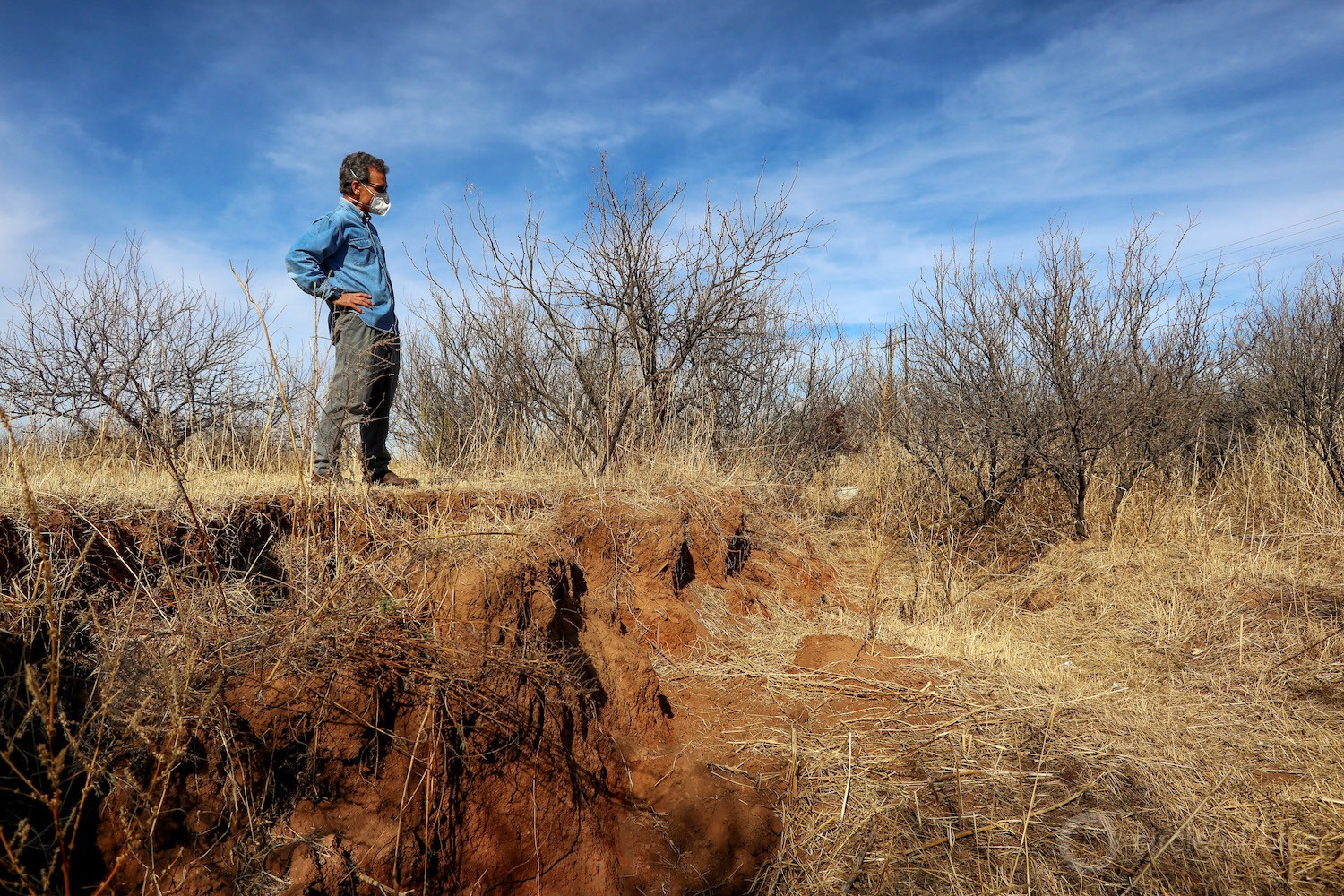
Steve Kiesel surveys a fissure, caused by gr0undwater pumping and land subsidence, that opened close to his home in Cochise County.
Keith Schneider / Circle of Blue
More than 50 miles north, Calvin Allred confronts similar risks. He says his wells also are dropping over 5 feet a year. Keeping the farm operating likely means reworking existing wells to reach water 1,000 feet below the surface, or drilling new irrigation wells that could cost $500,000 each.
He’s come to accept that the solution is some sort of local oversight program that prevents excessive pumping from Cochise aquifers. In other words, a rebalancing of priorities to give more weight to the public interest.
Williams, Kiesel, and Spencer are actively participating in a new local campaign, similar to the one being organized in Mohave County, to establish a rural water management area in Cochise County. Allred won’t get involved. In 2015 he participated in a local effort to bar new irrigation wells in the county and prevent any expansion of irrigated farmland. That plan would have required state approval. The Cochise campaign got rough and divided the farm community.
As a grower, Allred has real-world knowledge of water and economics. As a lawyer, he knows the outlines of water law. And as a longtime Cochise County resident, he’s intimately aware of differing opinions, clashing private and public interests, and the unforgiving politics that determine water supply, demand, and use.
How does Allred assess which way the balance should tilt? He put it this way: “My neighbor says he has the right to pump as much water as he wants to raise his crop. But what about my right to have enough water to raise mine?”
This project was made possible by a fellowship awarded by Stanford University’s Bill Lane Center for The American West.

